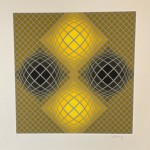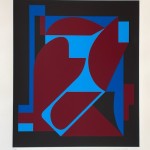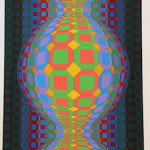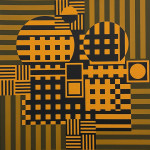VASARELY Victor
Victor Vasarely is an french-hungarian artist, born in 1906, in Pécs, Hungary. He is today seen as the “grand father” of the optical art movement, or Op Art.
After studying in Hungary with professors close to the Bauhaus movement, which strongly influenced him, Vasarely moved to Paris in 1931 as a graphic designer for advertising. From the 1950s onward, he formulated an abstract vocabulary in an initially “geometric” style, where flexible lines played a dynamic role. Then, he progressively developped kinetic art, where the interplay of the mechanisms of perception and optical illusions creates movements. Vasarely theorized this new aesthetic in a founding manifesto, the Yellow Manifesto in 1955 during the first Op art exhibition at the Denise René gallery, called Le Mouvement, where he presented his work alongside Agam, Cruz-Diez and Soto.
From then on, Vasarely’s work was characterized by geometric shapes and colorful graphics in order to establish illusions of depth on the surface of the canvas. Much more than just painting and sculpture, Vasarely worked in both the public space and homes, with numerous public commissions and a rich body of paper-based artworks, mostly serigraphs, helpingto democratize art. At his death in 1997, Vasarely left behind an immense body of work and an immutable mark in the history of 20th century art.





 Français
Français English
English